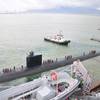The amphibious transport dock ship Pre Commissioning Unit (PCU) New York (LPD 21) under construction in Northrop Grumman Ship the shipyard. It is the fifth ship to be built in the San Antonio-class of amphibious ships. The bow stem is made of steel from the World Trade Centers and weighs 7.5 metric tons. New York is scheduled to be commissioned in the fall of 2008. U.S. photo by Mass Communication Specialist Seaman Santos Huante
As the ship nears 50 percent completion, the most unique characteristic of the LPD 21 New York's construction process is that the bow stem was formed using steel from the World Trade Center (WTC).
In August 2005 NGSS finished construction of the bow stem. Hoisting and welding the 7.5-metric ton bow stem to the ship was completed in August 2006.
“It’s a tremendous feeling,” said Capt. Bill Galinis, Navy program manager for LPD 21. “It’s a tie that will forever bind the Sailors and Marines who sail this ship with the citizens of New York.”
The idea for using steel from the WTC as part of the ship's frame could not be attributed to any one individual or organization. However, New York Gov. George Pataki worked to acquire the steel and deliver it to the Amite Foundry and Machine, Inc., Amite, La., as a gift from the citizens of New York to the Navy. The steel was treated and smelted for use as the ship’s bow stem (Unit 1120) during construction.
The bow stem is the foremost portion of the ship where it cuts through the water and offers hull integrity.
"The significance of where the WTC steel is located on the 684-ft.-long ship symbolizes the strength and resiliency of the citizens of New York as it sails forward around the world," said Cmdr. Quentin King, Navy program manager representative on site. "It sends a message of America becoming stronger as a result, coming together as a country and ready to move forward as we make our way through the world."
The design of New York and its sister ships directly reflects considerations given to the day-to-day activities of the Sailors and Marines who will serve aboard.
According to Galinis, Navy and Marine Corps teams came together in the early stages of the design process with ideas regarding improvements in berthing, messing spaces, increased training capabilities and the installation of a ship wide area network (SWAN).
Another innovation is how Sailors and Marines move throughout the ship.
“Electronically, we took the average Marine in full battle gear and ran them through the passageways of a three-dimensional model,” said Woody Oge, site director of New Orleans Operations, NGSS. “In that program we highlight in red everything he hits, and what we found in the initial design was we had to do some slight tweaking of piping system and power distribution or move certain systems, so we have a Marine move through the passageways unencumbered. This was done throughout the ship.”
“We had to realize early on it’s the Sailor and Marine who uses the ship [and they] are our customers,” continued Oge. “If we can make it a better facility for him to perform his mission, then we have done our job, and I think we have.”
In a ceremony Sept. 7, 2002, then Secretary of the Navy Gordon R. England declared the fifth amphibious transport dock ship of the San Antonio class to be named New York.
In keeping with the ship’s official motto of “Never Forget,” amphibious transport dock ship New York is slated for commissioning at its namesake city of New York in fall of 2008. Its homeport will be in Norfolk, Va.
By Mass Communication Specialist Seaman Santos Huante, Fleet Public Affairs Center Atlantic
Featured videos

Inmarsat Enhances Service to Drive Digitalization

Inside the Electrified Truckable Tug

Tracking Foreign Vessels Working in the U.S. Jones Act Market
Subscribe for
Maritime Reporter E-News
Maritime Reporter E-News is the maritime industry's largest circulation and most authoritative ENews Service, delivered to your Email five times per week








